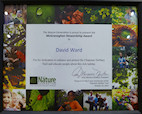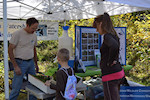

Overseeing the Water Resources of Loudoun County, VA
Awards Presented to Loudoun Watershed Watch
|
"2014 2007 Outstanding Organization" Presented to: David Ward Loudoun Watershed Watch Presented by: The Nature Generation .October 25, 2014 Naten bestowed the McGranaghan Stewardship Award to David Ward for his extraordinary efforts to protect the habitat at the trail and educate people about it. David helped us on our The Trail to Water Quality project with his overall guidance and also took special interest in helping the our high school students prepare the plan that they ultimately presented to the town council. During this project, we worked with students, schools, and the community to monitor the health of the South Fork Catoctin Creek which runs along the trail, establish baselines and track trends for different types of stream monitoring, and educate others about their findings and ways to improve water quality. Ward provided guidance and data throughout the duration of this project, responding quickly and thoroughly. Although the trail is only five years old, Mr. Ward has been active in stream monitoring for many years. He was part of the Catoctin Creek Stewardship Days held in 2005 and 2007; he participated in collecting more than 1,000 samples for the Catoctin Creek Bacteria Total Daily Maximum Load (TMDL) from 2005 – 2009; he taught bacteria monitoring under a grant through the Piedmont Environmental Council to Loudoun Valley High School students in 2007, and again through The Nature Generation’s grant from the EPA in 2012; and has been Secretary of “State-Appointed” Catoctin Scenic River Advisory committee since 2010. |
||
|
"2007 Outstanding Organization" Presented to: Loudoun Watershed Watch Catoctin Watershed TMDL Project. Presented by: Virginia Citizens for Water Quality .July 21, 2007 During the past three years over a dozen citizen volunteers have collected more than 500 water samples for bacterial analysis in order to help monitor and assess the on-going progress of the TMDL implementation on Catoctin watershed in Loudoun County. Using the Easy-gel method, samples are collected at 12 location in the 90-sq mile watershed every two weeks. Data collected do not indicate any significant reduction in E. Coli in the creeks. Higher stream flows (storm events) generally exhibit increased bacteria levels. Data and maps are posted on-line. Monitoring supplies have been funded through several DEQ and Chesapeake Bay Restoration Fund grants. |
info@loudounwatershedwatch.org Copyright © 2014 Loudoun Watershed Watch

